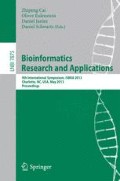Abstract
About a dozen years ago, Robin Gutell proposed that comparative sequence analysis of all ribosomal RNAs pointed to the existence of a “minimal ribosome”. Together we mapped the structure of the minimal ribosome in three dimensions by computer-based modeling. The resulting model (Mears et al. (2002) J Mol Biol 321:215-234) was subsequently confirmed in direct structural studies (Mears et al. (2006) J Mol Biol 358:193-212). The minimal ribosome points back toward the “prebiotic ribosome”, i.e., the RNA molecule that catalyzed peptide bond formation during the RNA World, before the appearance of the genetic code. We have been pursuing the prebiotic ribosome in collaboration with a group of scientists at the Georgia Tech Astrobiology Center, under the leadership of Loren Williams, using a variety of experimental and computational approaches. This work has led to recognition of the role of unusual RNA structures and interactions in a previously unexpected catalytic activity: RNA is capable of catalyzing coupled oxidation-reduction reactions, a key requirement for any system of prebiotic molecules with the capacity for metabolism and replication.
Many small icosahedral RNA viruses assemble spontaneously, without the need for a specialized apparatus or the input of energy. An understanding of assembly mechanisms would have obvious implications for the development of new antiviral treatments, and for the design of novel nanoparticles capable of self-assembly. We have developed the first complete model of any real virus in full atomic detail (Zeng et al. (2012) J Struct Biol 180:110-116), and we have also determined the structure of the viral RNA in vitro (Athavale et al. (2013) PLoS ONE 8:e54384). These studies contribute to the growing understanding that unusual RNA secondary structures play important functional roles in the viral life cycle.
In this talk, I will discuss the convergence of these lines of research, with particular emphasis on the search for novel signals in RNA sequences and secondary structures.
Access this chapter
Tax calculation will be finalised at checkout
Purchases are for personal use only
Author information
Authors and Affiliations
Editor information
Editors and Affiliations
Rights and permissions
Copyright information
© 2013 Springer-Verlag Berlin Heidelberg
About this paper
Cite this paper
Harvey, S.C. (2013). Unusual RNA Structures: Information Content in RNAs from the “Prebiotic Ribosome” to Modern Viruses. In: Cai, Z., Eulenstein, O., Janies, D., Schwartz, D. (eds) Bioinformatics Research and Applications. ISBRA 2013. Lecture Notes in Computer Science(), vol 7875. Springer, Berlin, Heidelberg. https://doi.org/10.1007/978-3-642-38036-5_4
Download citation
DOI: https://doi.org/10.1007/978-3-642-38036-5_4
Publisher Name: Springer, Berlin, Heidelberg
Print ISBN: 978-3-642-38035-8
Online ISBN: 978-3-642-38036-5
eBook Packages: Computer ScienceComputer Science (R0)

